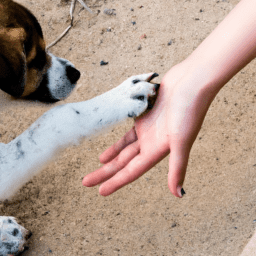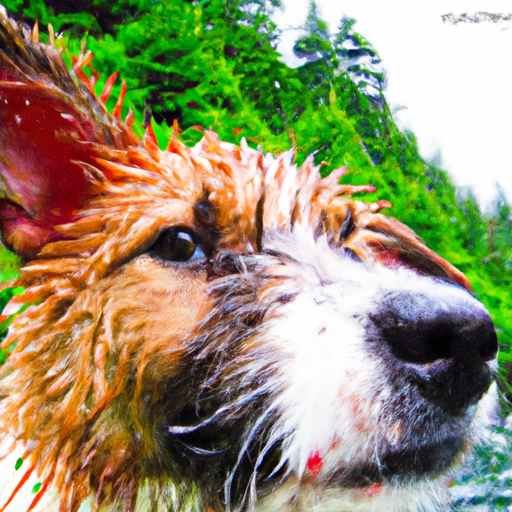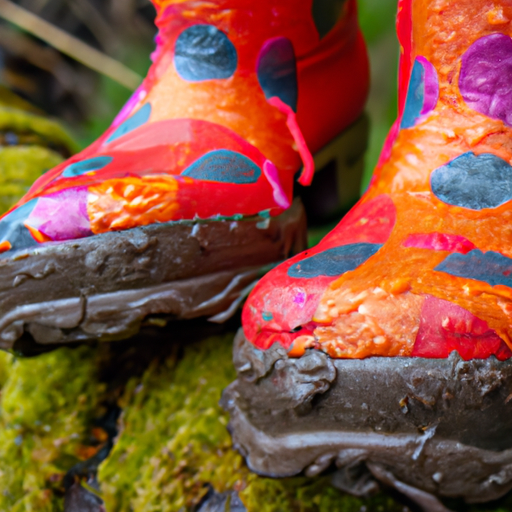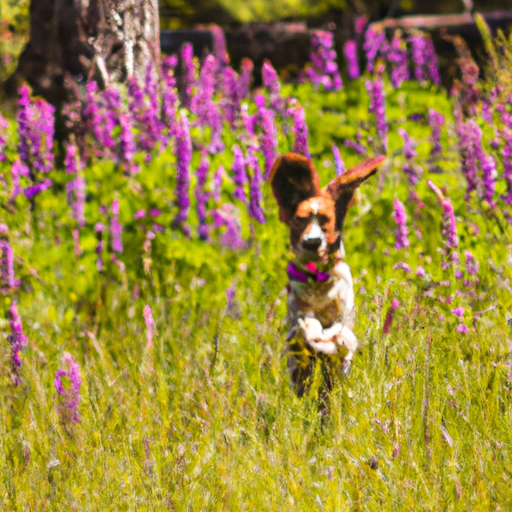If you've recently brought home a playful, energetic puppy, you may have already encountered the not-so-friendly habit of them jumping up on people. While it may be adorable at first, it can quickly become a nuisance, especially if your puppy is large or has sharp claws. Fortunately, there are a few simple strategies you can employ to discourage this behavior and teach your puppy to keep all paws on the ground. With a bit of patience and consistency, you'll soon be enjoying calmer greetings with your furry friend.
Understanding the Behavior
Why do puppies jump up?
When puppies jump up on people, it is often their way of seeking attention or showing excitement. They may also be trying to establish their dominance or establish a social connection. Jumping up is a natural behavior for puppies, as it is their way of interacting with the world around them.
Is it a problem?
While jumping up may seem harmless or even cute when a puppy is small, it can quickly become a problem as they grow. A small puppy jumping up may not cause any harm, but as they get bigger, their jumping can become more forceful and potentially injure someone. It is important to address this behavior early on to prevent it from becoming a bigger issue in the future.
Understanding the consequences of not addressing the behavior
Not addressing the jumping behavior of a puppy can have several consequences. Firstly, it can lead to discomfort and potential harm to the person being jumped on. Additionally, if the behavior is not addressed, the puppy may continue to jump up on people well into adulthood, which can become a safety concern. Furthermore, allowing the jumping behavior to continue sends mixed signals to the puppy about acceptable behavior, which can lead to other behavioral problems in the future.
Establishing Boundaries and Consistency
Setting clear rules and expectations
To prevent your puppy from jumping up, it is essential to set clear rules and expectations. Make it clear to your puppy that jumping up on people is not acceptable behavior. Consistency is key here, as mixed messages can confuse your puppy and delay their understanding of what is expected of them.
Consistency in enforcing boundaries
Once you have established the rules regarding jumping up, it is crucial to remain consistent in enforcing these boundaries. Every time your puppy attempts to jump up, calmly and assertively redirect their behavior and reinforce the expectation that all four paws should remain on the ground.
Importance of positive reinforcement
Positive reinforcement is a powerful tool when it comes to training your puppy. When they exhibit appropriate behavior, such as keeping all four paws on the ground, provide praise, treats, or other rewards. This positive reinforcement helps your puppy associate the desired behavior with positive outcomes, making them more likely to continue behaving appropriately.
Avoiding mixed signals
Consistency is vital in avoiding mixed signals. It is important to ensure that all family members and visitors are aware of the rules and expectations regarding jumping up. Inconsistency from different individuals can confuse your puppy and undermine the training efforts. Consistently reinforcing the desired behavior will ultimately help your puppy understand what is expected of them.
Training Techniques
Redirecting their attention
When your puppy starts to jump up, redirect their attention to an alternative behavior or action. For example, ask them to sit or lie down instead of jumping. By redirecting their focus, you are teaching them an alternative behavior that is more appropriate and manageable.
Teaching alternative behaviors
In addition to redirecting their attention, teaching your puppy alternative behaviors can be beneficial. By providing them with an alternative action, such as offering a toy or asking for a specific command, you are giving them an outlet for their energy and attention that does not involve jumping up.
Using rewards and treats effectively
Reward-based training is highly effective when it comes to curbing unwanted behaviors like jumping. When your puppy refrains from jumping up, reward them with treats, praise, or playtime. This positive reinforcement not only helps reinforce the desired behavior but also strengthens your bond with your puppy.
Implementing basic obedience training
Basic obedience training can be immensely helpful in teaching your puppy appropriate behavior. Commands such as “sit,” “stay,” and “down” can be useful in preventing jumping up. By teaching these commands, you are providing your puppy with clear instructions and alternatives to jumping.
Building self-control through exercises
Engaging your puppy in exercises that promote self-control can also be beneficial in preventing jumping up. Activities like “wait” or “stay” exercises can teach your puppy to control their impulses and stay calm in different situations. These exercises help develop your puppy's self-control and reduce the likelihood of them jumping up on people.
Managing the Environment
Controlling greetings and interactions
Take control of how your puppy greets and interacts with people. Instead of allowing them to jump up on everyone they meet, teach them to sit and wait for attention. By doing so, you are reinforcing the idea that they will only receive attention when they exhibit calm behavior.
Using baby gates or playpen
Using baby gates or playpens can help manage your puppy's access to different areas of the house. This can be particularly useful when you have guests over or during times when your puppy is more likely to become overly excited and jump up. By confining them to a specific area, you can control their behavior and prevent them from jumping on people.
Removing tempting objects
Remove any objects or items that may tempt your puppy to jump up. For example, if they tend to jump up when they see food on the kitchen counter, ensure that all food is stored securely and out of their reach. By removing these temptations, you can create an environment that supports the desired behavior and discourages jumping.
Creating a safe and calm environment
Creating a calm environment can help prevent your puppy from becoming overly excited and jumping up. Minimize loud noises, sudden movements, and chaotic situations, especially during training and when guests are present. A calm environment will encourage your puppy to focus on appropriate behavior rather than jumping up for attention or stimulation.
Socialization and Exposure
Positive experiences with new people
Socialization is a critical aspect of raising a well-behaved and well-adjusted puppy. Expose your puppy to a variety of people in positive and controlled settings. Encourage calm behavior during these interactions, and reward them for staying calm rather than jumping up. Positive experiences with different individuals will help your puppy develop good social skills and reduce the likelihood of jumping up out of excitement.
Gradual exposure to different environments
Gradual exposure to different environments can help your puppy become more confident and less prone to jumping up. Introduce them to new places and situations slowly, allowing them time to adjust and observe their surroundings. Positive experiences in new environments will help them feel more at ease and less likely to react by jumping up.
Engaging in puppy classes or playgroups
Puppy classes or playgroups provide structured and supervised environments for your puppy to interact with other dogs and people. These settings allow them to learn appropriate social behaviors and can help reduce the tendency to jump up. Enrolling your puppy in these classes can contribute to their overall social development and aid in preventing jumping behavior.
Working with Professionals
Consulting a professional dog trainer
If you are struggling to address your puppy's jumping behavior on your own, consider consulting a professional dog trainer. They can provide expert guidance and help implement effective training techniques tailored to your specific situation. A professional trainer can assess your puppy's behavior, identify any underlying issues, and provide personalized strategies to address the jumping.
Seeking guidance from a veterinarian
Your veterinarian is an excellent resource for addressing behavioral concerns in puppies. They can help determine if there are any underlying medical issues contributing to the jumping behavior and provide guidance on how to address it. A veterinarian can also recommend specific training techniques or refer you to a reputable dog trainer if necessary.
Considering puppy socialization classes
Puppy socialization classes are designed to help puppies learn appropriate behaviors and interact positively with other dogs and people. These classes often cover basic obedience and can be valuable in preventing jumping up. The structured nature of these classes and the guidance of a professional trainer can help address any jumping behavior and promote overall good manners in your puppy.
Dealing with Specific Situations
Jumping on strangers during walks
If your puppy tends to jump up on strangers during walks, it is essential to maintain control of the situation. Keep your puppy on a short leash and maintain distance between them and strangers until they can exhibit calm behavior. Reward your puppy with treats and praise for staying composed and not jumping up.
Jumping on family members
When your puppy jumps on family members, it is crucial to address the behavior immediately. Redirect their attention to an alternative behavior, such as sitting or lying down, and reward them for complying. Consistency in enforcing boundaries is key, as all family members should reinforce the same rules to prevent confusion.
Jumping on visitors
When visitors come over, it is essential to prepare your puppy for proper greetings. Keep them on a leash initially, and ask your guests to ignore the jumping behavior. Once your puppy has calmed down and can approach without jumping, reward them with treats and encourage gentle interactions.
Jumping during playtime
Jumping during playtime can be common, as puppies tend to get excited and lose control. Interrupt the jumping by redirecting their attention to an appropriate toy or command. Reinforce calm behavior by rewarding them when they engage in calm play without jumping.
Preventing Reinforcement of Jumping
Ignoring the jumping behavior
One strategy to prevent reinforcement of jumping is to ignore the behavior altogether. Refrain from giving any attention or rewards when your puppy jumps up. Instead, wait for them to calm down and have all four paws on the ground before acknowledging them positively.
Teaching the ‘off' command
Teaching your puppy the “off” command can be effective in discouraging jumping. Use this command when they jump up and reward them when they comply by getting off. Consistent practice and positive reinforcement will help them understand that jumping up is not acceptable behavior.
Avoiding punishment or physical force
Punishing your puppy or using physical force to prevent jumping is not recommended. These methods can create fear and anxiety in your puppy, potentially causing further behavioral issues. Positive reinforcement and redirection are more effective and humane approaches to discourage jumping behavior.
Remaining calm and patient
It is important to remain calm and patient throughout the process of addressing your puppy's jumping behavior. Consistency and positive reinforcement take time and effort, but with patience and persistence, you can successfully train your puppy to refrain from jumping up on people.
Handling Excitement and Energy
Providing regular exercise
Regular exercise is essential for managing your puppy's excitement and energy levels. Ensure they have opportunities to engage in physical activities like walks, runs, or play sessions. Sufficient exercise can help reduce the likelihood of excessive excitement and jumping up.
Engaging in interactive play
Engaging in interactive play with your puppy is not only a great bonding experience but also a way to channel their energy in a constructive manner. Use toys that encourage active play and provide mental stimulation. By redirecting their energy into play, you can help them release pent-up excitement in a way that does not involve jumping up.
Teaching relaxation techniques
Teaching your puppy relaxation techniques can be valuable in managing their excitement. Practice exercises such as “calm settle” or “down-stay” to help them learn to relax on command. Encouraging calm behavior will decrease the likelihood of jumping up during periods of excitement.
Setting realistic expectations
It is important to set realistic expectations when it comes to your puppy's behavior. Remember that they are still learning and developing self-control. While consistent training and positive reinforcement can greatly reduce jumping behavior, it may take time for your puppy to fully grasp the desired behavior. Stay patient and celebrate small victories along the way.
Consistency in Training and Reinforcement
Getting everyone on board
To effectively address your puppy's jumping behavior, it is crucial to get everyone in your household on board. Ensure that all family members are aware of the rules and expectations and consistently reinforce them. By working together, you can create a united front and avoid confusion or mixed messages for your puppy.
Ensuring visitors follow the rules
When guests come to your home, communicate the rules regarding your puppy's behavior and ask for their cooperation. Inform them of your training efforts to prevent jumping and explain how they should interact with your puppy. Consistent reinforcement of the rules by visitors will help reinforce the training and prevent any setbacks in behavior.
Reinforcing training during all interactions
Consistency is key in reinforcing your puppy's training. Whether you are at home, on walks, or visiting others, consistently reinforce the desired behavior. Reward appropriate behavior and redirect or ignore jumping. By maintaining consistency in all interactions, you are helping your puppy understand and adhere to the rules regarding jumping.
In conclusion, preventing a puppy from jumping up on people requires understanding the reasons behind the behavior, establishing clear boundaries and expectations, utilizing effective training techniques, managing the environment, socializing and exposing them to various situations, seeking professional guidance when needed, and consistently reinforcing desired behavior. With patience, consistency, and positive reinforcement, you can help your puppy develop good manners and become a well-behaved member of your family and community.






